How to choose an HR software system in 2025: A complete guide
Buying the right HR tools is more critical than ever. This step-by-step guide to HR software will help you identify your needs and pinpoint the features that matter most.
An HR system is one of the most important purchases an organization makes. The stakes couldn't be higher: The market for HR tools has exploded and people management has become an urgent priority amid today's tight labor market and significant social change.
This overview gets you off to a strong start. It explains all the key steps in setting up an effective buying process and identifies the HR software features that ultimately determine whether a product will meet your needs. Throughout, links will take you to articles with details on important related topics.
What is HR software?
HR software encompasses the myriad tools organizations use to manage daily HR processes, such as recruiting, onboarding, training, payroll, benefits, time and attendance, performance management and succession planning.
While HR software was originally inward facing and focused on the administrative tasks of HR departments, today's products make the art and science of developing an organization's human resources -- its people -- available to every employee.
Types of HR software
HR software usually comes as a suite of modules, each one designed for a specific HR process.
The most comprehensive platforms go by several names:
- Human resource management system (HRMS).
- Human resource information system (HRIS).
- Human capital management (HCM).
The terms are often used interchangeably, but there are discernible differences in HRIS vs. HRMS vs. HCM. In short, HRIS and HRMS are near synonyms for actual software platforms you can buy, while HCM is an umbrella term for both HR processes and software.
These comprehensive suites typically include the following categories of software modules, which can often be bought separately:
- Core HR (benefits, employee records, payroll, etc.).
- Talent management (compensation, learning, performance, recruitment, succession).
- Workforce management (scheduling, time and attendance).
- Service delivery (employee and manager self-service, help desks).
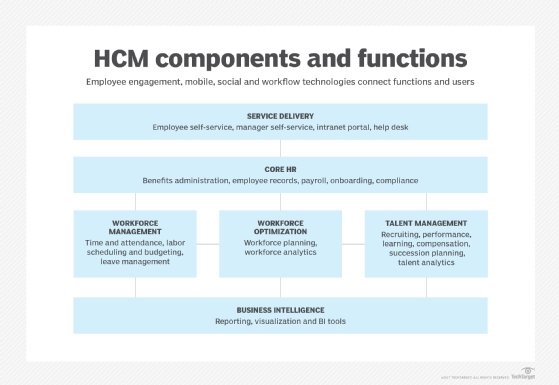
Benefits of HR software
HR software enables organizations to digitize the record-keeping, computation and communication tasks performed by the HR department and distribute some of those responsibilities throughout the organization. Functions such as time and attendance, payroll, recruiting, regulatory compliance and benefits administration can be moved off paper and managed -- usually more efficiently -- on computers. This partial automation of manual tasks can reduce labor costs, streamline HR processes and make them more effective.
However, the effect of the technology goes far beyond these commonplace benefits of HR automation. When more employees perform better and reach their full potential, the result is often improved creativity and productivity that ultimately leads to higher profits.
Latest trends in HR software
Societal trends in work-life balance, employee satisfaction and diversity that were magnified by the COVID-19 pandemic, in tandem with emerging technologies that are infiltrating every aspect of business, are today having a major impact on HR processes and software. Here are six of the most influential trends.
- AI. Artificial intelligence can spot patterns, choose among options and make predictions -- all things people do when recruiting, evaluating and developing talent. Automating those processes with AI can make them more accurate and efficient. HR software vendors have been aggressively adding AI capabilities, including newer generative AI (GenAI) with humanlike communication skills for writing recruitment emails, creating educational content and developing career paths.
"AI is changing everything," said Brian Sommer, president of the TechVentive consultancy. "It's changing the products, the business case, the scope, the outcomes, the procurement process and more." But there are major concerns that the technology can sometimes amplify rather than eliminate racism, sexism and other biases. Companies are also uneasy about leaving important decisions up to a technological "black box."
Sommer cautioned buyers to watch out for vendors who charge extra for new AI features -- such as modeling and analytics -- as AI-driven workflows begin doing the work of traditional modules, including recruiting and workforce management.
"What you thought was an application? That definition is expanding and changing, and may have contractual and monetary implications," he said. "Readers need to fasten their seatbelt, put a padlock on the corporate bank account and prepare to have some tough-love conversations with software vendors if they start getting greedy."
- Augmented reality and virtual reality. AR overlays digital information on a real-world environment, while VR attempts to digitally simulate an entire environment. Both are beginning to transform corporate learning by providing virtual hands-on experience with the tools and procedures employees need to learn for their jobs. The use of AR and VR in HR-driven training could help avert a knowledge crisis resulting from the mass retirement of baby boomers.
- Blockchain. A database technology for distributing records across a chain of computers, blockchain makes data essentially permanent and largely immune to hacking. Bitcoin is the most famous blockchain application, but companies have begun to explore its potential for sharing employee records and other HR information. Initial uses for blockchain HR technology include securely transmitting payroll documentation, candidate credentials and employment contracts. However, deployments are few, and significant technical hurdles and distrust sown, in large part, by high-profile cryptocurrency fraud will have to be overcome for blockchain to see widespread adoption.
- Mental health. Workers' struggles with isolation and stress from COVID-19 lockdowns and remote-work expectations sparked renewed interest in supporting mental health on par with physical health. Today, employers continue to bolster their benefit packages with mental health and wellness apps and portals.
- Remote and hybrid work. Since the end of pandemic lockdowns that forced most white-collar employees to work from home, companies have struggled to formulate new requirements and incentives for working in the office. Many have adopted new hybrid models that combine home and office work. The physical dispersal of the workforce has driven demand for video conferencing software, team collaboration tools and other hybrid workplace technologies. HR software vendors have responded with new features for remote performance management and recruitment, employee engagement, monitoring and wellness.
- Robotic process automation. By mimicking human actions, RPA bots -- some capable of AI-based decision-making -- can execute common HR processes, such as benefits selection, expense reimbursement and resume-sorting faster and more accurately. Vendors began adding RPA to their HR products several years ago, but the recent focus is on agentic AI that is intelligent enough to automate decisions and make recommendations.
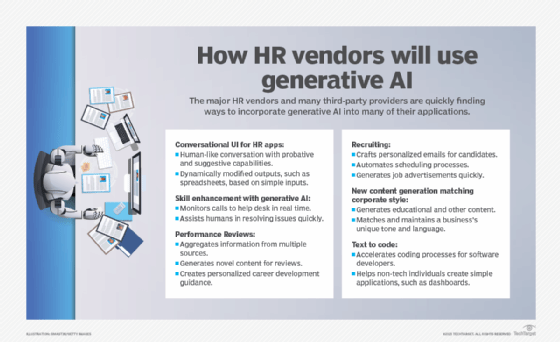
Keys for evaluating HR software
How do you find the products that have the basic functions and specific features your organization needs the most? And how can you scrutinize vendor spec sheets and demos to compare products in enough detail to make the right choice?
"Features and functionality aren't much help because most products are mature and do the same things," Sommer said. "The issue is which products do a killer job of solving your most complicated, messed-up functions or process pain points."
One of the most common HR software buying mistakes is looking for products that automate existing processes. Sommer advised that organizations instead take time to investigate what's possible with new and innovative HR technologies, reimagine their HR or talent management processes, and then pick a vendor they believe can close the gap between idea and reality.
Another common mistake is seeing HR systems as silos and failing to develop a long-term architectural vision that accounts for data management, privacy and integration between key systems, said Josh Bersin, HR analyst and founder of The Josh Bersin Company.
Bersin recommended instead treating HR software selection like a product management strategy that calls for monthly and annual investments in technology. First, identify the organization's biggest objectives, such as growth or productivity, before conducting research to find vendors that fit the organization's size. Then get references from customers in the same industry, experiment with different vendors and establish partnerships with them. Expand the vendor relationship beyond the salesperson to the product team and executives, he said, "so you really feel like this is a vendor that fits hand in glove with your needs."
Here are the typical steps in the software selection process:
- Create a strategy to evaluate HR tools. Define the organization's biggest workforce challenges, needs and goals.
- Assemble a cross-disciplinary buying team. Include representatives from HR, IT and finance, as well as departmental managers and staff who will use the software.
- Identify requirements. List what is important to the organization in an HR software system. The criteria should cover technology requirements and business issues, such as international compliance needs.
- Identify potential vendors. Use a variety of research methods -- from market reports to discussions with other companies -- to generate a list of possible vendors. Then, narrow it down to five to 10 vendors to approach for more information.
- Send a request for proposal to the shortlist of vendors. The RFP should be clear and concise and include information about your organization, the project, timeline, submission rules and scope, as well as a vendor questionnaire.
- View demos. Ask each vendor to build demos around actual use cases from your organization. Fully scripted demos that show the exact steps for employees are the best way to judge a module's capabilities and determine if a product will deliver.
- Read case studies. Find customer stories that include deployment and adoption challenges. Ask vendors for reference customers who can answer questions directly.
Who is responsible for buying HR software?
Organizations need to put some thought into who should be on the HR software buying team. The following are typical roles and responsibilities.
Sponsor. This is the main person overseeing the project, typically someone in the C-suite, such as the chief human resources officer (CHRO), CIO or CFO. They make the big decisions and keep the initiative aligned with the business strategy.
Selection manager. The selection manager is the de facto project manager for the product evaluation and selection process. This is often a senior HR manager, such as the HRIS director, or a member of the central project management office.
Selection advisor. Typically, this role is filled by an outside consultant, but it could be an internal person with similar expertise in requirements planning, RFP preparation and other formal steps.
Subject matter experts. These are the people who know the most about the important business processes the new system will manage, such as HR administration, payroll, benefits, recruitment and compensation.
Demo team. This group comprises HR staff and subject matter experts who will use the new system and can ask HRMS vendors questions related to departmental needs, along with IT staff who support those functions, including senior IT management.
Building a business case for new HR software
HR software suites aren't cheap. Annual costs can range from several thousand dollars for the smallest SMBs to more than $5 million for large enterprises. To buy such an expensive system, you first have to convince decision-makers to pay for it. That's why an HR software business case is essential. The best ones combine quantitative analysis that impresses CEOs and finance directors with qualitative information that reflects the daily needs of users.
Here are the major steps:
- Requirements gathering. Solicit feedback from users and key stakeholders on current HR processes and measure their efficiency.
- Systems assessment. Investigate the current HR system's ability to meet the identified requirements, costs such as HRIS maintenance, and what a new system could do.
- Templating. Collate the data, feedback and requirements in a standard document and prepare the business case.
- Benefits measurement. Quantify how the new system can improve HR processes.
- ROI calculation. Plug in costs and benefits metrics to show when the system begins to pay for itself.
- Audience identification. Identify the key stakeholders and decision-makers and gear the case to their individual needs.
Organizations often skimp on systems assessment and fail to evaluate their HRMS thoroughly enough to see if it can meet their current requirements, said Eric St-Jean, an independent HR technology consultant and Informa TechTarget contributor. It might have unused features that are up to the task. But careful evaluation can also reveal shortcomings that make the need for a new system clear, such as frequent complaints from employees, problematic interfaces to important systems or an inability to accommodate growth.
It's also important to rightsize the system to stay within budget, St-Jean said. Large, complex systems from big vendors often bring extra consulting and training costs to implement them and keep them running.
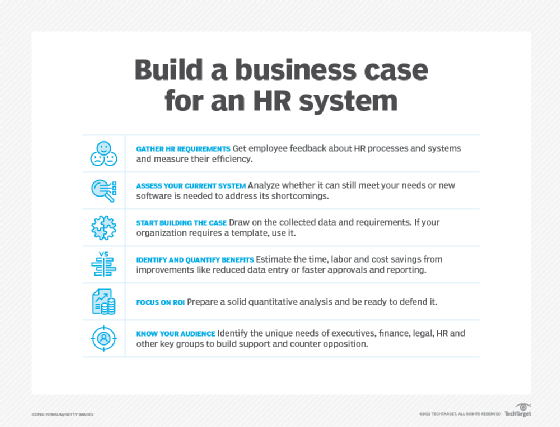
Negotiating the best deal
When it comes to negotiating terms and price, Sommer recommends not being shy about it.
"Everything is negotiable, and if your company is of any consequence, the vendor is going to move and bend," he said. "If they don't, you haven't gotten high enough up in the organization to find somebody with the appropriate authority to make that change."
He likes to tell the vendor's CEO their company is likely to be in the finals and ask, if the buyer raises an issue that could be a deal killer, whether the vendor's account executive can call the CEO directly.
"They want the transaction, make no mistake about that," Sommer said. "The salesperson, on the other hand, is struggling with conflicting metrics. They need to do a deal and get it closed, but they also need to make sure it hits certain margins and other targets and introduce time delays and cost issues that shouldn't be there."
HR software features to consider
Vendors will usually claim to handle most of your requirements, which makes it hard to choose between them. But certain features help separate contenders from pretenders. Here is a rundown of features and leading-edge technologies that can make the biggest difference in improving HR processes, organized by the main software modules in core HR, talent management, workforce management and service delivery.
Core HR
The reason many companies, especially SMBs, buy their first HRMS is to create a paperless HR system. Electronic employee records are at the center of these systems and remain the foundation of HR technology.
One big differentiator, according to Sommer, is the presence of a payroll module. Some HRMSes don't have one. The next question to ask is about the type of integration with third-party payroll providers. An HRMS that handles payroll might need to outsource part of this function to pay overseas employees, for example.
Another feature worth asking about is pay on demand, which lets employees get paid before their scheduled payday. It's recently in hot demand, Sommer said, and increasingly popular with middle-income workers after starting out as an option typically chosen by low-income workers.
Sommer also advised making sure core HR systems can fully handle contingent workers -- such as freelancers and contractors -- which includes providing accurate headcounts without needing separate types of software, and giving them security IDs and other tools full-time employees receive.
It is also important to have core HR that keeps data in one place, St-Jean said. Some data can reside elsewhere, such as performance management software, but storing the vast majority in core HR will avoid having to run separate reports. The best products also come with a variety of flexible reporting and dashboard tools.
"Try and get your data in a good place first, write out your requirements, and then find the new system that will let you merge all the data," he said.
Benefits administration
Managing standard benefits, such as health, dental, life and disability insurance, 401(k) retirement plans, tuition reimbursement and tax-advantaged flexible spending accounts, is a longstanding function of core HR.
Many companies have been moving these functions from their on-premises computers to cloud-based providers. New health insurance platforms and wellness portals take healthcare beyond the basics to provide online access to providers, medical advice and fitness communities. If you're eyeing a separate health and wellness platform, Sommer advised making sure it integrates with financials so you can more easily manage the tax and compliance implications of health benefits.
When buying benefits technology, most of your focus will be on setting up partnerships with benefit providers rather than the software used to administer them.
The technical issues center on whether a particular type of software integrates with your company's HRMS. First, verify that a vendor supports your company's full menu of benefits. Look for tools that help tailor the system to handle the complex workflows needed to administer your rules and policies. Also look for strong security features that make it easy to fine-tune the access granted to different types of employees.
Payroll
The payroll module or outside service should have the following:
- Support for every country where the company does business, which could be through a variety of payroll providers.
- The ability to create and file the appropriate tax documents and other compliance requirements.
- Integration with core financials, typically in ERP, to ensure accounting records reflect the latest payroll.
- Support for global pay-equity analysis.
Compliance
HR departments are responsible for keeping an organization in compliance with the many regulations affecting employment, from fair labor practices to antidiscrimination laws and workplace safety. That's why it's important for core HRMS software to have a breadth of tools not only for monitoring business practices that can have legal implications but also for preparing all the paperwork required by local, state and national governments.
Check if vendors support the following:
- Every type of documentation, including all forms, tables and exhibits your organization is required to file.
- AI, analytics and other mechanisms for ensuring that talent management modules don't run afoul of discrimination laws by allowing sexism and other illegal biases.
- Employee records storage that follows privacy laws, such as the EU's GDPR, especially for HR software vendors who use public cloud services from other providers.
Onboarding
The onboarding process, especially an employee's first-day experience, can determine how long they stay.
"The big problem here is: Will the software integrate with all the non-HR solutions, and is there workflow and exception handling for all of that?" Sommer said.
To onboard an employee, HR professionals must coordinate an array of processes, from issuing a security badge and laptop to ordering uniforms and scheduling orientation -- much of it in a specific sequence. Coordinating these steps requires an onboarding module that ideally integrates with the IT, time clock and other systems needed to set up a new employee.
Onboarding is often included in core HR, in part because it involves employee records, benefits and compliance. However, many vendors consider onboarding to be more of a talent management function because it comes right after the recruiting process, draws on corporate learning tools and potentially has a major impact on employee performance.
Offboarding is the mirror image of onboarding, with the steps done in reverse order.
Other features to investigate include the following:
- Integration with learning systems, so new employees can get quickly trained on required systems and processes and see training opportunities for new career paths.
- Surveys and other tools that make it easy for departing employees to give feedback, regardless of whether they have done an exit interview; using these tools consistently helps build a database you can analyze.
- Ease of use, which is vital to incoming employees.
- The ability of HR to track progress.
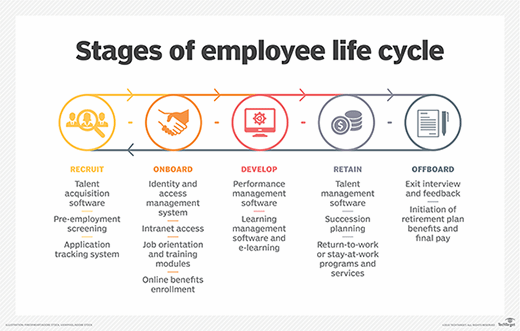
Talent management
After core HR, talent management is the most important driver of HR software purchasing and product development.
Talent management systems cover a vast array of disciplines and processes for bringing people with the right experience and potential into the organization, developing their skills, motivating them, assessing their performance, compensating them, and retaining them or easing their departure.
In recent years, the emphasis in talent management has shifted to skills development and greater awareness of how skills fit into job descriptions and career paths.
That means paying attention to how well a product can capture skills and translate them into job roles that are updated regularly. Besides significantly improving talent management processes, skills-oriented software can help companies with difficult decisions, such as furloughs and layoffs.
But that no longer means having to build a skills database, which was once recommended for reorienting talent management toward skills, Bersin said. Employees don't want to waste time checking boxes in long lists of skills they have or want.
The real issue is figuring out how to apply skills technology to pressing problems, such as hiring engineers or assessing leaders and low performers. "That's where the action is -- not in building this giant database of skills and making our HR system look like LinkedIn," he said.
One increasingly common way for companies to develop employee skills is the use of gig marketplaces, a technology that began as a way for freelancers to find jobs but is now used internally by some companies to advertise projects that require certain skills to employees.
Better visibility into the relationship between skills development and career growth helps employees see opportunities to grow inside the organization. It can also improve employee retention and help organizations maintain productivity during hiring freezes.
No discussion of talent management today can avoid generative AI. The technology's dramatic surge in popularity in 2022 has arguably disrupted talent management more than any other part of HR.
"The whole idea of talent management was 'We're going to manage this person from the minute they come to work for us as a job candidate all the way through their career to become a senior manager or executive until they retire.' And that's just not the way companies work," Bersin said.
Instead, people come and go, change jobs, sometimes change professions or shift to part-time employment. "These systems have to be very flexible and very intelligent so that they can accommodate these more complex use cases," he said. As a result, traditional, integrated talent management suites are becoming dated as vendors strive to add AI to accommodate buyers' expectations for intelligent workflows and analytics.
But while AI's capabilities are impressive, St-Jean injected a note of caution and advised only choosing tools that have proved their usefulness. He questioned the practicality, for example, of AI that can write an offer letter to send to a candidate. "No legal team in their right mind is going to let HR have AI generate an offer letter and give that to somebody," he said.
Furthermore, the usefulness of AI tools can diminish over time. St-Jean gave the example of GenAI that writes job descriptions -- one of the first HR applications of the technology. But now applicants use those same tools to rewrite their resumes to suit different job descriptions, and recruiters then use AI to identify resumes that match. "Of course there's going to be a match," he said.
Compensation management
Many companies have a giant spreadsheet that shows employee salaries and job titles, plus the salary ranges for each job, perhaps adjusted for local markets, according to Sommer. "The problem is, where do you get the data?" he said.
Ideally, the compensation management system comes with a prepopulated big-data service. If it doesn't, buyers should ask how much it costs to buy data from a provider and how current the information is. Salary databases are often outdated just when they're needed for employee performance or compensation reviews.
Other differentiating features include the following:
- Support for different kinds of compensation, such as stock options and variable compensation for companies that are heavily sales-oriented.
- Compensation histories for every employee.
- The ability to import external data and run calculations without affecting work done by a compensation planner.
Learning and development
The on-premises learning management system (LMS) is a common legacy platform in organizations that were early to the HR software market. In recent years, many LMSes have been modernized and moved to the cloud.
But, the most important development in workplace learning is the rise of affordable new learning resources, such as short instructional videos on YouTube and TikTok and the free massive open online courses from universities and companies that specialize in distance learning.
Finding useful, ready-made educational content can be a challenge, so companies often turn to third-party providers, but they can be expensive. For those that already have an LMS, the issue is whether it's possible to import content from these new sources. Leading-edge products have AI that can recommend training based on past selections and career paths, similar to the way Netflix's AI makes recommendations based on streaming history.
In recent years, learning experience platforms (LXPs) have begun to replace LMSes because of their ability to discover and deliver external content in a personalized, consumer-grade UI that gives employees more control over the learning process.
Some organizations add an LXP as their primary means of interacting with employees but retain their LMS for record-keeping. Buyers who want to pursue this model should first understand the differences between an LXP and an LMS and make sure the systems are well integrated.
It's also important to have good integration between the career planning and learning features of the talent management suite so employees can formulate career paths and identify gaps in their skills and education.
Learning is another HR process that AI is quickly transforming, according to Bersin, whose company introduced Galileo, a GenAI digital assistant for HR practitioners, in 2023.
"AI has absolutely spectacular characteristics for training and education," Bersin said, citing its ability to automatically generate personalized content.
He said LMSes won't necessarily be retired, but the learning technologies that run on top of them -- including LXPs -- will start to be replaced this year by AI-centric tools, which have a high ROI.
Look for these options in learning and development tools:
- A large variety of learning formats, including classroom, remote, paper-based, video and audio, both live and on demand.
- Capabilities that make it easy for employees to create learning content, such as recording videos on smartphones and providing searchable transcripts.
- A rich library of courses and materials on a wide range of relevant topics, including the tools that employees use in their jobs and courses that meet certification requirements of your industry.
- Support for experience API, an integration standard that helps apply analytics to learning to monitor employee use and improve the offerings.

Performance management
For at least a decade, many companies have been replacing paper-heavy annual reviews with continuous performance management, which provides tools for coaching and feedback to help employees continuously improve their performance. Social media and email integration enable employees to send kudos and "nudges" to co-workers and make such feedback a regular part of their daily workflow.
Sommer said organizations should look for performance management software with strong analytics features. "The analytics are going to tell you where your problems and opportunities are." Workflow and exception-handling features help you do something about them.
Also, look for the following capabilities:
- Integration with learning systems so employees can improve their skills or take mandatory training.
- Retention analytics to identify leaders and other high performers at risk of leaving.
- Integration with the compensation management module, which can provide the ability, for example, to analyze how modest across-the-board raises affect the morale of high performers.
- Workflow features that can move reviews to the next stage instead of waiting for everyone to respond.
- The ability of managers and their direct reports to enter data simultaneously.
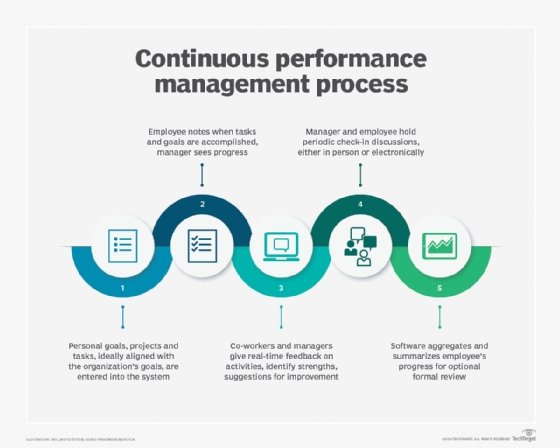
Recruiting
The perennial war for talent makes recruiting difficult for many companies.
Talent management suites have more tools for recruiting than for any other HR function. Talent acquisition remains a buzzword, with the market for recruiting software in constant flux and startups entering every year.
Some organizations only need basic functions, such as an applicant tracking system (ATS), online job postings and a process for moving candidates from the application stage to the job offer. Others want more innovative features, such as candidate relationship management, the ability to pull in resumes from a variety of sources and good visibility into candidates as they move through the hiring pipeline.
Other features to look for include the following:
- SMS texting, which helps reach candidates who lack access to laptops or PCs and prefer texts over voice calls.
- A record of every contact with a candidate on every communication platform used.
- Natural language processing for analyzing unstructured data, such as text messages.
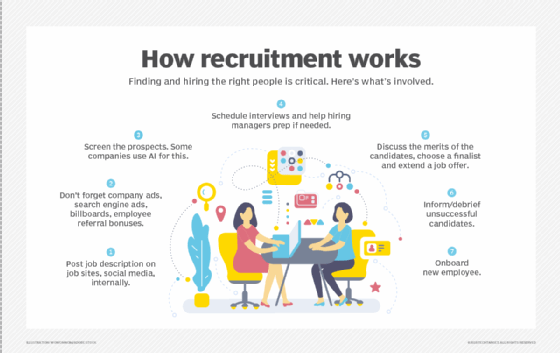
Succession planning
Some talent management suites have a succession planning module that helps organizations plan for what should happen when executives and other high-value employees leave. It can also help retain good employees by spotting signs of dissatisfaction and providing career paths.
Ease of use is critical here -- especially if people outside of HR, such as senior managers, need to use the tools.
The best tools also have the following features:
- What-if capabilities for considering different reporting structures and reorganizations, or the effect of corporate mergers on succession.
- An org chart tool that goes beyond static PDFs and makes it easy to move large chunks around.
- Close integration with learning management tools to facilitate career development for employees earmarked for eventual promotion.
- The ability to plan succession for non-executive-level employees.
Job postings and job boards
There was a time when companies posted every listing to as many job boards as possible. Nowadays, job postings usually cost money, and the priority is managing postings so they will be as effective as possible. Recruiting modules now have GenAI tools to help create job descriptions and postings.
Important features include the following:
- Integration with popular job boards and others you want to use.
- Support for other digital channels, such as social media and text, for more precise targeting of promising candidates.
Video interviewing
Basic video interviews simply involve using webcams to replace in-person meetings. Video interviewing software is much more sophisticated: It lets an employer send the same set of questions to thousands of candidates to produce interviews in a consistent format and then uses AI to analyze candidates. The technology is often used to winnow down the list for in-person second interviews, but it carries the risk of AI introducing bias in hiring.
Look for these key features:
- Tools and procedures for detecting bias in the software's recommendations.
- Easy ways to move around and make notes in videos and jump quickly among videos.
- Automated transcriptions you can easily search for keywords that suggest in-demand skills.
Employee engagement and recognition
Employee engagement has been a growth area for tech startups, and major HR platform vendors have acquired these niche players or built their own tools. The dizzying number of options makes choosing one a special challenge.
Employee surveys are a popular tool for measuring and boosting employee engagement. The most helpful software has a large selection of premade surveys with cross-tabulation capabilities. Ease of use is key because most users are department managers or HR staffers who aren't savvy about technology.
Also, look for the following options:
- Easy ways to attach documentation and data that support badges and other types of recognition.
- Strong integration with email and collaboration platforms.
- The ability to export recognition data to the performance management system.
- The ability to synthesize survey data in near real time.
Workforce management
Workforce management systems enable organizations to monitor and improve employee productivity. In addition to tracking the time it takes to complete tasks and projects, workforce management can also identify opportunities to better deploy employees and skill sets.
Though it has obvious affinities with talent management, workforce management is a separate discipline, often with separate software devoted to it.
Workforce planning
In contrast, workforce planning software drills down into the details of assigning workers to specific jobs. It's heavy on HR analytics tools, as executives and HR managers parse external demographic and labor data alongside internal data to spot pending shortages or decide where to reassign employees to better address strategic priorities.
At the same time, workforce planning can be extremely detailed and help decide, for example, whether to call in two more retail clerks for a weekend sale.
Scheduling software is the primary tool of workforce planning. It's especially valuable if it lets employees schedule themselves while ensuring that shifts will be covered, which is key to retaining employees in certain professions, according to Sommer.
Workforce planning is another common target for innovative AI, Bersin said, because there's an urgent need to retain contingent and hourly workers with more sophisticated shift-scheduling tools that let them choose their preferred shifts and locations, as well as to compensate those workers appropriately. This segment represents around a third of the workforce and is the most affected by labor shortages.
"AI tools can do a great job of optimizing the workforce planning activity," added Sommer. "They can identify the staffing mix that provides the best shift coverage, minimizes overtime, honors training commitments, meets payroll cost requirements, etc. Some tools can optimize several dozen factors simultaneously and handle factors like employee time and day preferences, travel times, time-off requests and more."
Before purchasing, check for the following:
- Daily tracking of individual employees' security credentials, including whether they have been revoked.
- Awareness of certification requirements of jobs, ability to assess certification validity and expiration date, and links to an LMS or LXP for related training.
- Notification when employees are nearing weekly hours that will require paying them benefits or overtime.
- The ability to let employees quickly record that they have completed their scheduled shift.
Service delivery
The days when employees simply walked down the hall to ask a question or pick up a form at their HR department are a relic of the past. As companies digitize and more employees work remotely, service delivery has become an important aspect of ensuring employees receive the HR services they need.
HR service delivery has been a growth area in HR tech, with vendors adding help desks, chatbots and feedback tools.
The platforms can be challenging to set up in-house, integrate with HR systems and populate with enough data and documentation, which often makes them a better fit for large companies than for SMBs.
Employee self-service
Enabling employees to change their personal information, benefit elections and beneficiaries can save time for HR professionals.
Vendors have worked to make these employee self-service (ESS) features available on employees' personal devices, but there are limits. "Trying to switch shifts with somebody may be impossible to do on a smartphone because there's just not enough screen real estate to get the whole picture," Sommer said.
Look for these features:
- Smartphone access to most self-service functions.
- Support for other devices -- including shop floor tablets, break room computers and point-of-sale systems -- if the workforce is mostly employees who lack smartphones and home computers and need other ways to access ESS.
- Easy update capabilities, so employees can see each other's current availability.
Manager self-service
Managers need self-service features that go beyond ESS by providing access to the HR and business functions, applications and data they need to perform their supervisory roles.
Here's what to look for in manager self-service features:
- Remote access to the full range of applications, with the same level of security and privacy as in-house systems.
- Department-wide visibility into work schedules to help with vacation approvals and other changes.
David Essex is an industry editor who covers enterprise applications, emerging technology and market trends, and creates in-depth content for several TechTarget websites.







